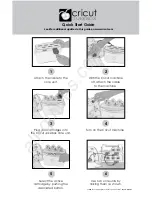
EI-1000 & 2000: Setup, Calibration and Troubleshooting.
Page 9 of 19
Display shows, “n0 0” when the zero button is pressed.
•
The zero button is limited in normal operation to prevent someone from
accidentally zeroing a full scale. To bypass this error if needed, go to the
Calibration
section. Enter the cal mode and do steps 1,2,3 and 7.
•
Faster way!
If the front cover is open close dip switch #4. The gross
light(s) will flash. Press the zero button. Open switch #4. Done!
Display stays at zero or goes up slightly when placing a know weight on
the scale
and/or
Unstable weight readings:
•
On the DCS-302 or DS-750 the shipping nut or bracket may not have
been removed. Flip the deck over. The nut or bracket is located under the
square box and holds the long lever(s) up against the deck.
•
The EDS-400 uses foam to hold the long lever up against the deck for
shipping. Flip the deck over and remove the foam if it’s still there.
•
On any scale with a hinge and a load cell mounted on top of the deck,
make sure the foot is sitting on the floor and the bolts mounting the load
cell are not touching the floor.
•
On the EI-1000 with a single scale the scale should be wired to TB4
(seven position terminal).
•
The EI-1000 comes with a jumper shorting the +S,-S, and –E terminals on
TB5. If it was moved to TB4, replace it on TB5
•
The LP4310 and LP4300 have adjustable feet. Make sure the foot has not
been backed out so far during leveling that the threaded rod is hitting the
underside of the deck.
•
Recheck the wiring. If the +E wire comes loose or is broken it can cause
the instrument to stay at zero. Check the load cell and instrument cables
for any damage.
•
Measure the + & - E terminals on TB4 or TB5 with the power on. You
should have 5 volts DC across them. If 5 volts is not present, kill the
power. Disconnect the scale(s). Apply power and measure the + & - E
terminals on the CPU board. If 5 VDC is present the scale or wiring has a
short.
Note: If you measure 10 Volts, that’s OK. Older indicators had 10 VDC excitation.
•
Make sure there isn’t anything stuck under the scale and the sides of the
scale are not rubbing against anything.
•
Check the corner readings on any scale with four load cells or four feet
(Ex. LP4300, WP1000, C3600, C7200 ). Place a weight on one corner at a
time. The corner with the lowest reading most likely has a mechanical or
electrical problem. A corner that reads high may also have electrical
problems such as a wrong load cell or bad summing box.










































